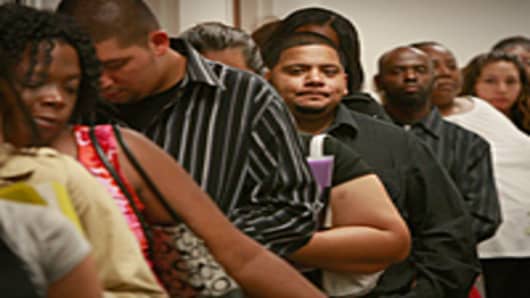Everyone these days is citing the findings of Narayana Kocherlakota of the Minneapolis Federal Reserve explaining why unemployment rate has risen even while the job vacancy rate has as well.
Kocherlakota states:
Since December 2000, the Bureau of Labor Statistics has been keeping data on the job openings rate, which is defined as the number of job openings divided by the sum of job openings and employment. Not surprisingly, when job openings rise, the unemployed can find jobs more readily, and the unemployment rate typically falls. The inverse relationship between the unemployment rate and the job openings rate was extremely stable throughout the 2000-01 recession, the subsequent recovery, and on through the early part of this recession.
Beginning in June 2008, this stable relationship began to break down, as the unemployment rate rose much faster than could be rationalized by the fall in job openings. Over the past year, the relationship has completely shattered. The job openings rate has risen by about 20 percent between July 2009 and June 2010. Under this scenario, we would expect unemployment to fall because people find it easier to get jobs. However, the unemployment rate actually went up slightly over this period.
What’s going on? Kocherlakota argues that a mismatch between the skills the economy is demanding and the ones workers have ready at hand is driving unemployment up. He calculates that if we had a normal match between workers skills and employer needs, then the unemployment rate would be 6.5 percent, not 9.6 percent.
How did worker skills get so out-of-sync with the market for those skills? Some of it is geographic and related to the housing meltdown—workers trapped in homes with underwater mortgages cannot move to where the jobs are being offered.
But something more is at work here. What we are seeing is a version of a capital allocation problem that is all too familiar to students of Austrian economics. From the perspective of Austrian economics, booms in business cycles produce misallocations of capital. Low interest rates produce an illusion of wealth that results in over-investment in parts of the production cycle further removed from the consumer. As the inevitable bust occurs, projects that once seemed profitable are revealed to be money losers. As the real levels of available investment capital and consumer spending become clear, many of those projects need to be unwound.
The same thing that happens to investment capital occurs with human capital. People spend years during the boom acquiring skills in boom sectors of the economy—such as home building, mortgage lending, real estate agenting. When it turns out that there is less demand than was thought for those skills, we wind up paying the price for the misallocation of human capital with high unemployment. Which is to say, the mismatch was not created by the downturn—it was created by the misallocation of human capital during the previous boom.
I must say that I think the policy response offered by Kocherlakota and Mike Konczal (who is filling in for Ezra Klein at the Washington Post) would be counter-productive. Both of them would extend unemployment benefits infinitely. I think this would be dangerous.
Their rationale for extending unemployment benefits is rather straightforward. Because the skills mismatch is the cause of much of our unemployment, the risk of additional unemployment occurring from people who prefer to lounge around and collect unemployment checks is low. Many of these people simply won’t be employable until they develop the right skills or the economy demands their skills once again. Finally, unemployment isn’t the fault of the workers: the economy just doesn’t want them right now.
Let me say that this final point is the strongest. Our government—through the Federal Reserve’s interest rates pro-home ownership policies, and bank capital standards that loaded the dice in favor of mortgage lending—created the housing inflation that led to the misallocation of capital. Faulting those misled by these policies is perverse.
But endless unemployment benefits could have a serious cost. One check on government-created human capital bubbles is for workers to individually grow skeptical about the sustainability of the bubble—the same way investors do about financial bubbles. In the case of workers, we’d expect a skeptical worker to begin diversifying his skills or seeking employment outside of the bubble.
Removing limits on unemployment could remove the incentive for individual workers to second guess the bubble. This would mean that the skills mismatch would actually grow worse in the next boom-bust cycle. That’s not something that is good for businesses, workers, or the economy.
_____________________________________________________
Questions? Comments? Email us atNetNet@cnbc.com
Follow John on Twitter @ twitter.com/Carney
Follow NetNet on Twitter @ twitter.com/CNBCnetnet
Facebook us @ www.facebook.com/NetNetCNBC



